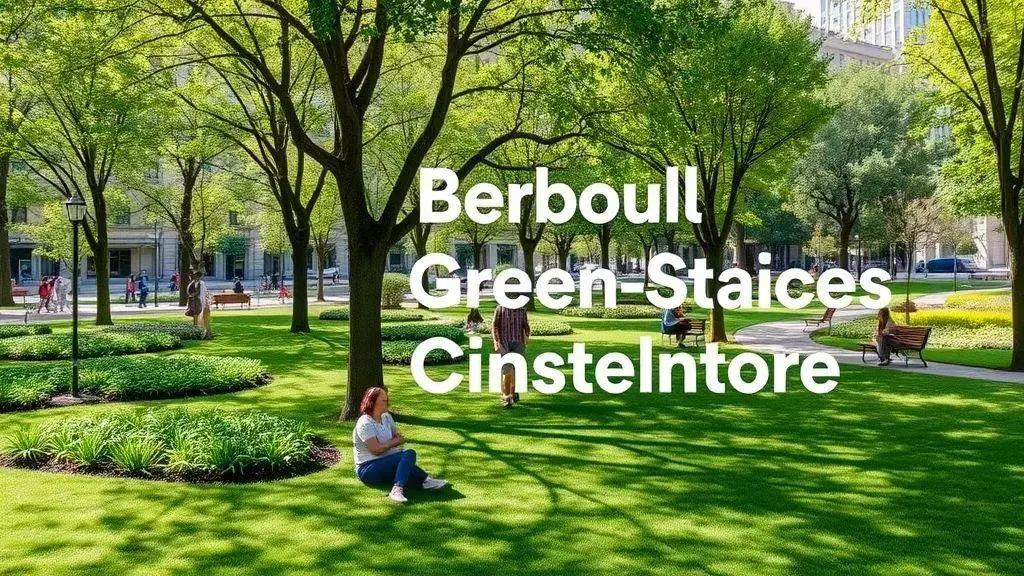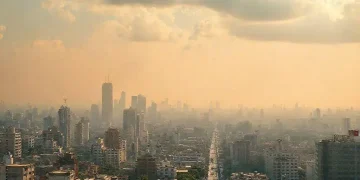Urban green space initiatives: transforming city living

Urban green space initiatives enhance city life by providing environmental benefits, promoting community engagement, and improving mental health through accessible parks, gardens, and innovative designs that incorporate technology.
Urban green space initiatives are changing the landscape of cities, making them more livable and sustainable. Ever wondered how little pockets of nature can enhance your daily life? Let’s explore!
Understanding urban green spaces
Understanding urban green spaces is essential in appreciating how they enhance city life. These areas, which include parks, gardens, and green roofs, provide many benefits to urban dwellers. They improve air quality, offer recreational opportunities, and create habitats for wildlife. In addition, urban green spaces serve as a vital part of city infrastructure.
The role of greenery in cities
The presence of plants and trees in urban areas significantly impacts public health and well-being. Research shows that people living near green spaces tend to report higher levels of happiness and lower stress levels. Access to urban green spaces encourages physical activity, such as walking and jogging, which is crucial for maintaining a healthy lifestyle.
Benefits of urban green spaces
- Enhance property values and reduce urban heat.
- Improve overall mental and physical health of residents.
- Promote biodiversity by providing habitats for various species.
- Encourage community interaction and social cohesion.
Moreover, these green areas help manage stormwater runoff, reducing flooding and improving water quality. By absorbing rainwater, plants in urban green spaces play a critical role in mitigating the effects of heavy rainfall. As cities continue to grow, integrating green spaces into urban planning becomes increasingly important.
Community gardens are another fantastic example of how green spaces can foster a sense of community. They not only provide fresh produce but also offer a platform for residents to come together, share knowledge, and collaborate on local projects. The effects of such initiatives often extend beyond the garden itself, strengthening neighborhood bonds and promoting sustainability.
In conclusion, understanding urban green spaces is vital to creating healthier, happier cities. Their numerous benefits illustrate why incorporating greenery into urban areas should be a priority for planners and communities alike.
Benefits of urban green space initiatives
The benefits of urban green space initiatives extend far beyond mere aesthetics. These initiatives enhance the quality of life in cities by providing essential environmental, social, and health advantages. By integrating green spaces into urban planning, communities reap numerous rewards that contribute to overall well-being.
Environmental Benefits
Urban green spaces play a crucial role in improving air quality. Trees and plants absorb carbon dioxide and filter pollutants, leading to cleaner air for all residents. Additionally, green areas help mitigate the urban heat island effect. This is where cities become significantly warmer than rural areas due to human activities and built environments. By incorporating vegetation, temperatures can be reduced, providing comfort during hot weather.
- Enhance biodiversity by providing habitats for wildlife.
- Reduce stormwater runoff, decreasing flooding risks.
- Improve soil quality and prevent erosion.
- Create noise buffers in busy urban areas.
Moreover, urban green spaces support local ecosystems, making cities more resilient to environmental changes. They become vital resources for various species, promoting biodiversity while allowing residents to connect with nature.
Social Benefits
These initiatives also foster community interactions and social ties. Parks and gardens serve as meeting points for residents, encouraging engagement and collaboration. A well-maintained green space can become a hub for community events and activities, creating a sense of belonging among individuals. This sense of community can help reduce crime rates and improve overall safety within neighborhoods.
Moreover, access to green spaces can elevate mental health. Studies indicate that spending time outdoors in natural environments reduces stress and anxiety while enhancing mood. Regular interactions with nature can lead to increased feelings of happiness and fulfillment, making urban living more enjoyable.
Furthermore, green spaces provide opportunities for physical activity. Parks with walking paths, bike trails, and recreational fields encourage active lifestyles, contributing to better overall health. Residents are more likely to engage in exercise when access to nature is readily available.
Key examples of successful projects

There are numerous successful projects that highlight the effectiveness of urban green space initiatives. These examples demonstrate how cities can transform neglected areas into vibrant community assets. Understanding these projects can inspire other cities to implement similar changes.
New York City’s High Line
The High Line in New York City is a prime example of reimagining an old space. This elevated park was created on a disused railway track and has become a popular destination for locals and tourists alike. The project features walking paths, gardens, and seating areas, showcasing the potential of transforming urban structures into green oases.
Chicago’s Millennium Park
Millennium Park in Chicago is another impressive project. It offers large green spaces, art installations, and performance venues. This park revitalized the city center, attracting visitors and boosting the local economy. It serves as a model for integrating arts and nature in urban settings.
- Provides a venue for community events and concerts.
- Features beautiful landscaping and walking paths.
- Encourages urban wildlife through biodiversity.
- Increases tourism and local engagement.
Both parks emphasize how urban green spaces can enhance the city’s appeal while providing essential recreational areas. Another noteworthy initiative is the Gardiner Expressway in Toronto, which converted expressway space into urban gardens and pathways, promoting sustainability and improving air quality.
Singapore’s Gardens by the Bay
Singapore’s Gardens by the Bay is an ambitious project that integrates nature with urban design. This garden complex features futuristic structures, vast greenhouses, and artistic installations, making it a world-renowned attraction. It reflects Singapore’s commitment to sustainability and conservation, showcasing that green spaces can also serve educational purposes.
These successful projects provide valuable insights into how urban areas can embrace nature. By utilizing innovative designs and community involvement, cities can create green spaces that enhance their residents’ quality of life and promote environmental health.
Challenges in implementing green initiatives
Implementing green initiatives in urban spaces comes with its share of challenges. While the benefits are significant, various obstacles may hinder progress. Understanding these challenges is essential for creating effective solutions.
Funding and resources
A major barrier is securing adequate funding for green projects. Cities often have limited budgets, which can lead to competition for resources. Finding financial support through grants or public-private partnerships is crucial for the success of initiatives. Many cities struggle to allocate necessary funds, delaying or limiting green space development.
Community engagement
Another challenge is ensuring community engagement and support. Successful green initiatives require public backing. If residents do not see the value of such projects, they may resist or even oppose them. To overcome this, cities must actively involve the community in planning processes, creating spaces that reflect the residents’ needs and preferences.
- Host public forums to gather input and ideas.
- Provide educational resources on the benefits of green spaces.
- Encourage volunteer programs to foster community involvement.
- Engage local organizations to build support.
Additionally, the maintenance of green spaces poses ongoing challenges. Once established, these areas require regular upkeep to remain appealing and functional. Cities must ensure they have the staff and resources to maintain these spaces. Neglecting maintenance can turn vibrant parks into undesirable areas that residents avoid.
Bureaucratic hurdles
Bureaucratic hurdles can also slow down the implementation of green initiatives. Navigating through local regulations and permits often complicates projects. Long approval processes can delay the start of even simple projects, discouraging potential improvements. Streamlining these processes would greatly benefit urban green initiatives.
In summary, tackling the challenges in implementing green initiatives is essential for enhancing urban spaces. By addressing funding issues, fostering community engagement, ensuring maintenance, and reducing bureaucratic barriers, cities can successfully create healthier and more sustainable environments for all residents.
Future trends in urban green spaces
The future of urban green spaces is evolving with innovative trends that aim to enhance city living. As cities grow, the demand for more green areas increases. Understanding these trends can help communities plan for a sustainable future.
Vertical gardens and green roofs
One exciting trend is the rise of vertical gardens and green roofs. As space becomes limited, cities are looking upwards to create new green areas. Vertical gardens can be seen on building walls while green roofs provide plants and flowers on rooftops. These solutions not only beautify cities but also contribute to energy savings and insulation.
Smart technology integration
Another trend is the integration of smart technology into green spaces. Cities are using sensors and data analytics to monitor the health of plants and the needs of visitors. This technology can help maintain green areas efficiently. For example, sensors can determine moisture levels and automatically water plants when needed. This ensures that parks and gardens stay vibrant with minimal waste.
- Use of drones for maintenance and monitoring.
- Community apps to share events and updates.
- Interactive installations that educate visitors.
- Sustainable lighting solutions powered by solar energy.
Additionally, the concept of multifunctional spaces is gaining traction. Urban areas are turning parks into multifunctional hubs where people can gather, exercise, and participate in events. This encourages social interactions and improves the quality of life. Events and workshops can take place in these green spaces, turning them into community focal points.
Native landscaping
Emphasizing native plants is another important trend. Using native species in urban green space designs can improve biodiversity and reduce maintenance needs. Native plants are adapted to the local climate, making them hardier and easier to care for than non-native species. This encourages wildlife and creates a more sustainable ecosystem within the city.
In summary, the future of urban green spaces looks promising with these evolving trends. By incorporating vertical gardening, smart technology, multifunctional spaces, and native landscaping, cities can create healthy, sustainable environments for their residents.
FAQ – Frequently Asked Questions about Urban Green Space Initiatives
What are urban green spaces?
Urban green spaces are areas with vegetation in cities, such as parks, gardens, and green roofs, that provide recreational and environmental benefits.
How do green spaces improve mental health?
Spending time in green spaces can reduce stress, enhance mood, and promote overall well-being, leading to improved mental health for residents.
What role does technology play in urban green initiatives?
Technology helps monitor plant health, manage resources efficiently, and engage the community through smart apps and data analytics.
Why is community involvement important for green projects?
Community involvement ensures that green spaces meet the needs of residents and fosters a sense of ownership and pride in local initiatives.





